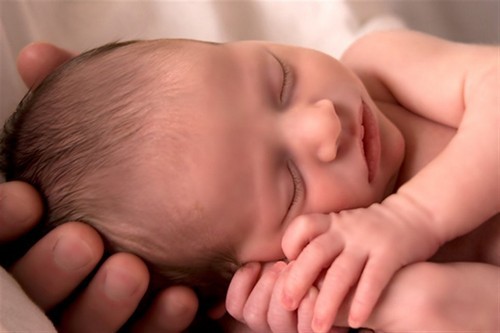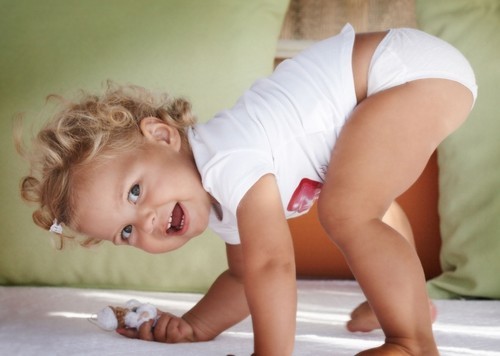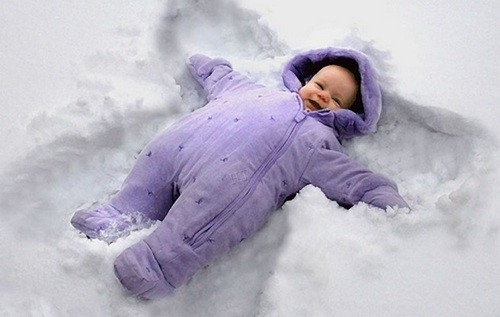The first thing new parents and their relatives are interested in, learning about the baby, is what height and weight he has. And few people know that the circumference of the head of the newborn is also of great importance and says a lot about the physical condition of the child.
What can be judged by measuring the diameter and volume of the head of a new man? Let’s try to figure it out.
Pediatricians have a special table that reflects all the norms of the physical development of an infant up to a year. And besides height and weight, there is a huge attention paid to the size of his head. These indicators allow doctors to judge how well a newborn baby is growing.
Features of the shape of the head in a newly born man
When the fetus passes the birth canal, it experiences pressure and adjusts to it. The bones of the skull of newborn children are not yet fused together and are mobile relative to each other. This is conceived by nature itself in order to minimize the risk of injury. That is why the shape of the head of a person who has just been born is somewhat elongated, oblong. Over time, the feature will pass, and there is no need to be afraid, this is a physiological norm.
A table showing the size and girth of the head of a newborn begins with 35-37 cm, which is considered the average for a healthy child. Any strong deviation up or down indicates pathology and requires careful observation. It is possible that during birth the birth trauma occurred, and this affected the head of the baby. This is quite common, especially if the birth was natural, and is successfully treated.
And if there was a cesarean section?
If the baby was born through surgery, his head will be slightly different. It is not for nothing that doctors say that Caesar’s head is smooth and beautiful, because they did not experience any pressure, because they did not pass through the birth canal. Nevertheless, this is also the norm. Read more about how development occurs in children after cesarean section →
The only thing you need to know: in a child who was removed from the mother’s womb operatively, the circumference and volume of the head is slightly larger than that of a person born naturally. A feature may persist for up to a year. That is why such babies often have narrower breasts than heads. But this does not say at all that there was a birth injury, just such is the development of Caesarean. And to be afraid that your child does not have a big head at all, over time everything will be aligned.
So, the shape of the head of the newborn should be elongated, uneven, sometimes slightly compressed in the temple area. The kid is not yet able to hold it himself, so he throws it back, which is also the norm in itself. In a newborn who has undergone a caesarean section, the shape of the head is more even, and the volume and circumference may be slightly larger than those that the table has.

What indicator is not considered correct and when should you pay special attention to this side of the development of the child?
Physiological norm and deviations from it
So, the usual is a girth of 35-37 cm, slight fluctuation in both directions is allowed. If the differences are significant, then this can be a lot of reasons, and young parents need to know about them.
Birth injury
This is one of the main reasons that the head of a newborn has abnormalities. The consequences may be different, but for the most part they are eliminated by the year or even earlier. Most often, the cause of the trauma may be the incorrect behavior of the mother during childbirth, a mismatch in the size of the fetal head and pelvis of a woman, and other features of the process of the appearance of a man in the light. All this is treated and in itself is not so scary.
Congenital diseases
This is worse than a birth injury. The reason that the baby has a large head may be, for example, hydrocephalus. What it is? This is a very serious disease, often fatal. However, you should not be scared right away. A progressive disease is characterized by a very severe course, accompanied by a divergence of the sutures of the skull and violations of not only physical but also mental nature. True hydrocephalus is associated with excessive intracranial fluid and is rare.
In addition, if the newborn’s head size is much smaller than the norm suggests, this can indicate microcephaly. And again, you shouldn’t panic right there. As a rule, the circumference and volume of the baby’s head directly depends on the hereditary predisposition, and this factor should also be taken into account. True microcephaly is a rare disease and is diagnosed at the stage of intrauterine development.
So, different factors can affect the diameter of a child’s head, including not only certain diseases, but also the trauma that occurred during childbirth. Sometimes a phenomenon such as hemangioma, a benign tumor that looks like an enlarged birthmark, can be observed. It manifests itself in the first days of the life of a newborn. When parents notice her, they are invariably frightened, but again in vain. What harm can be from hemangioma? In principle, no, if it is removed in a timely manner.
Features of changes in the head with the growth of the child: shape, girth and size
So, we examined all the features of the circumference and volume of the head of a newborn baby. What progress can be observed during the first year of a baby’s life and when to expect first success from a newborn?
The baby, just born, is completely helpless, he does not hold his head, but only powerlessly throws it back. And it doesn’t matter how the labor was going on and what method of delivery was used: all new people are equally helpless. The size of their head seems simply huge compared to a small body, and even if the circumference is normal, all the same for the baby, his head seems simply too heavy, and for the first few weeks he will throw it back. In order to train a newborn, it should be laid out more often on the tummy: in this position, after some time you will see how the baby holds its head upright and looks at the space in front of it. When will this happen? After about 2-3 weeks of constant training.
By the month a healthy baby, as a rule, is already quite confidently holding his head and trying to twist it, but you should still hold it with your hand, because it can inadvertently twitch. The size of the skull increases, and with it the diameter and volume grow. The shape, so uneven at first, is becoming more and more rounded. By the month the child is already less likely to throw the head back, and its girth becomes approximately 3 cm larger.
At 2 months, the shape of the head is already much more even, and the diameter increases by an average of 2 cm. When your child reaches the age of 3 months, he no longer throws back the head, but surely rotates it. Only if there was a birth injury, then development can be a little slower.
Further, progress is proceeding at such a pace. At 3 months, the head circumference of the baby increases by about 1 cm, and this will continue until six months. Thus, the diameter of this part of the body in a six-month-old baby should be 8-10 cm more than the initial one on average. The shape becomes proportional, and the size decreases compared to the body.
By year, the head circumference should be approximately 10 – 12 cm more than that of the newborn. This is due to the fact that in the second half of life, the diameter monthly increases by only half a centimeter. In general, growth with weight gain in this period also becomes less intense. As a rule, a one-year-old child has a head circumference of approximately 45-48 cm.
The fontanel at this time in most children is already completely tightened. Toddlers are becoming more curious and mobile, despite the fact that they had a birth injury, or everything went well. And more and more trouble and worries are added to parents every day, but they are the most pleasant and joyful!

Young parents should carefully monitor their baby and understand his mood and physical condition. Many norms are not true for absolutely all children, and can fluctuate within certain limits. Each baby has its own pace of development and its own characteristics, and if he feels well, eats with appetite and actively learns the world around him, then everything is in order with him. This is the basic truth that all mothers and fathers must learn.
Table of normal values of the head circumference
| Age | Head circumference indicators, cm | |||||||
|---|---|---|---|---|---|---|---|---|
| Year / month | Month | Very low |
Low | Below average |
Middle | Above average |
Tall | Very tall |
| 0: 0 | 0 | 30.3 | 31.5 | 32.7 | 33.9 | 35.1 | 36.2 | 37.4 |
| 0: 1 | 1 | 33.0 | 34.2 | 35.4 | 36.5 | 37.7 | 38.9 | 40.1 |
| 0: 2 | 2 | 34.6 | 35.8 | 37.0 | 38.3 | 39.5 | 40.7 | 41.9 |
| 0: 3 | 3 | 35.8 | 37.1 | 38.3 | 39.5 | 40.8 | 42.0 | 43.3 |
| 0: 4 | 4 | 36.8 | 38.1 | 39.3 | 40.6 | 41.8 | 43.1 | 44.4 |
| 0: 5 | 5 | 37.6 | 38.9 | 40.2 | 41.5 | 42.7 | 44.0 | 45.3 |
| 0: 6 | 6 | 38.3 | 39.6 | 40.9 | 42.2 | 43.5 | 44.8 | 46.1 |
| 0: 7 | 7 | 38.9 | 40.2 | 41.5 | 42.8 | 44.1 | 45.5 | 46.8 |
| 0: 8 | 8 | 39.4 | 40.7 | 42.0 | 43.4 | 44.7 | 46.0 | 47.4 |
| 0: 9 | 9 | 39.8 | 41.2 | 42.5 | 43.8 | 45.2 | 46.5 | 47.8 |
| 0:10 | 10 | 40.2 | 41.5 | 42.9 | 44.2 | 45.6 | 46.9 | 48.3 |
| 0:11 | eleven | 40.5 | 41.9 | 43.2 | 44.6 | 45.9 | 47.3 | 48.6 |
| 10 | 12 | 40.8 | 42.2 | 43.5 | 44.9 | 46.3 | 47.6 | 49.0 |
| thirteen | fifteen | 41.5 | 42.9 | 44.3 | 45.7 | 47.0 | 48.4 | 49.8 |
| sixteen | eighteen | 42.1 | 43.5 | 44.9 | 46.2 | 47.6 | 49.0 | 50.4 |
| nineteen | 21 | 42.6 | 44.0 | 45.3 | 46.7 | 48.1 | 49.5 | 50.9 |
| twenty | 24 | 43.0 | 44.4 | 45.8 | 47.2 | 48.6 | 50.0 | 51.4 |
| 2: 3 | 27 | 43.4 | 44.8 | 46.2 | 47.6 | 49.0 | 50.4 | 51.8 |
| 2: 6 | thirty | 43.7 | 45.1 | 46.5 | 47.9 | 49.3 | 50.7 | 52.2 |
| 2: 9 | 33 | 44.0 | 45.4 | 46.8 | 48.2 | 49.7 | 51.1 | 52.5 |
| thirty | 36 | 44.3 | 45.7 | 47.1 | 48.5 | 49.9 | 51.3 | 52.7 |
| 3: 3 | 39 | 44.5 | 45.9 | 47.3 | 48.7 | 50.2 | 51.6 | 53.0 |
| 3: 6 | 42 | 44.7 | 46.1 | 47.5 | 49.0 | 50.4 | 51.8 | 53.2 |
| 3: 9 | 45 | 44.9 | 46.3 | 47.7 | 49.2 | 50.6 | 52.0 | 53.4 |
| 4-0 | 48 | 45.1 | 46.5 | 47.9 | 49.3 | 50.8 | 52.2 | 53.6 |
| 4: 3 | 51 | 45.2 | 46.7 | 48.1 | 49.5 | 50.9 | 52.3 | 53.8 |
| 4: 6 | 54 | 45.4 | 46.8 | 48.2 | 49.6 | 51.1 | 52.5 | 53.9 |
| 4: 9 | 57 | 45.5 | 46.9 | 48.4 | 49.8 | 51.2 | 52.6 | 54.1 |
| fifty | 60 | 45.7 | 47.1 | 48.5 | 49.9 | 51.3 | 52.8 | 54.2 |



